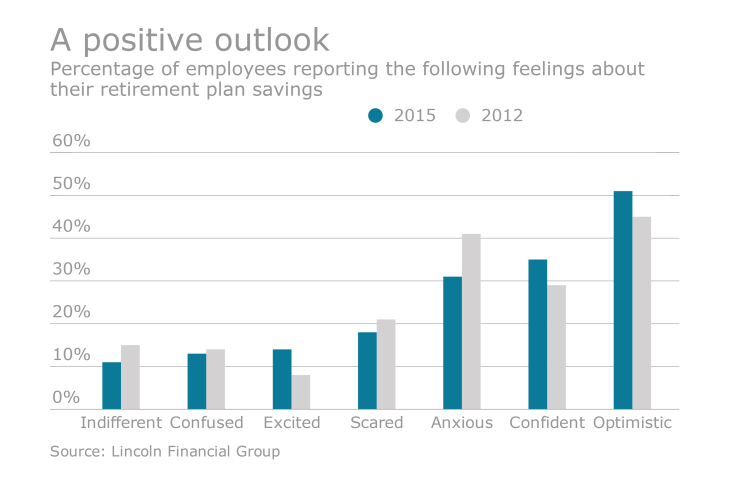Americans’ retirement preparedness improved from 2015 to 2016, in large part because more employees are running projections for their post-employment years, according to data compiled by Financial Finesse in its 2016 Year in Review.
“This is good news for employers that face significant costs due to delayed retirement from employees that are underfunded or don’t have an idea whether or not they have enough to retire,” the Financial Finesse report found. “By running a retirement projection, about four in 10 discovered they are underfunded and in need of making changes with respect to how much they save, how they invest, and how they prepare for retirement.”
The remaining six in 10 were on track for retirement and confident in their ability to reach their savings goals, the report found. Despite the advances, slightly more than half of respondents weren’t sure if they were on track for retirement and had taken no steps to figure out how to get there.

Overall
“That’s very important because it is close to a level of sustaining to reach their overall financial goals,” says Linda Robertson, director of planner operations and a certified financial planner for Financial Finesse.
If people score in the 0 to 2 range, they are suffering financially. This means they are having trouble paying the bills and dealing with debt, according to Financial Finesse.
“One unexpected expense could set off a series of cascading negative consequences that can lead to retirement plan loans, hardship withdrawals, and wage garnishments,” the report found. Employees on the opposite end of the scale, with a financial wellness score of 9 to 10, exhibit solid financial behaviors and are moving forward toward their personal financial goals.
Financial Finesse looked at 69,081 financial wellness assessments that were taken between 2015 and 2016 to come up with its year-end findings. In that assessment, employees are asked common questions that a financial planner might ask during a one-on-one meeting, examining their cash flow, debt and retirement savings.
The assessment found a 6 percentage point gain year over year in the number of employees who claimed to have a handle on their cash flow.
“That means freeing up more money to focus on their future financial goals,” Robertson says. There also was a 4 percentage point improvement in the number of people who have an emergency fund, and a 5 percentage point improvement in those reporting they contributed to their workplace retirement plan.
The millennial gap
Another interesting finding from the Financial Finesse data was that a high percentage of millennials feel their financial situation has improved and are ready to purchase a home. Forty-five percent of millennials reported that buying a home was their top financial priority in 2016, compared to only 27% in 2015.
The gender gap is getting wider, according to Cynthia Meyer, a certified financial planner with Financial Finesse and lead author of the report. In 2015, there was only a 5 percentage point gap between males and females. In 2016, the gap had widened to 7 percent points.
The widest gap is in the area of investing and money management.
“Both men and women showed increased confidence in their investment strategy but the slope is a little bit higher for men. Looking at cash flow management and debt, 70% of women say they have a handle on cash flow compared to 81% of men,” Meyer says.
The biggest disparity is between those who say they are on track for retirement. As the economy has improved, men beat out women by 10 percentage points when it came to saying they were on track for retirement.
Financial Finesse found that women are more likely to use workplace financial wellness programs than men, but they also claim to need the program more. Of everyone who took the assessment, 80% of the people who said they were in financial crisis were women.
The biggest differentiator between those with the lowest and highest levels of financial wellbeing was behavior, according to Robertson.
Those on the lower end of the financial wellness range were the ones living paycheck to paycheck and were not well equipped to handle unexpected emergencies. Of that group, only 13% said they had a handle on cash flow; 8% said they had a handle on debt and 41% said they had taken a retirement plan loan or hardship withdrawal from their retirement accounts.
Of those on the higher end of the scale, 100% said they had a handle on their cash flow; 96% said they were comfortable with their debt and only 7% had taken a retirement plan loan or hardship withdrawal.
To get employees to take advantage of their financial wellness offerings, Meyer recommended that employers keep in mind five best practices: Remind employees that the benefit is not something they have to pay for and nobody is going to sell them anything; and offer them incentives to participate; encourage employees to use technology to measure their progress. Employers also need to integrate financial wellness with other employee benefits; and give employees the opportunity to speak to a financial coach, on the phone or in person.





